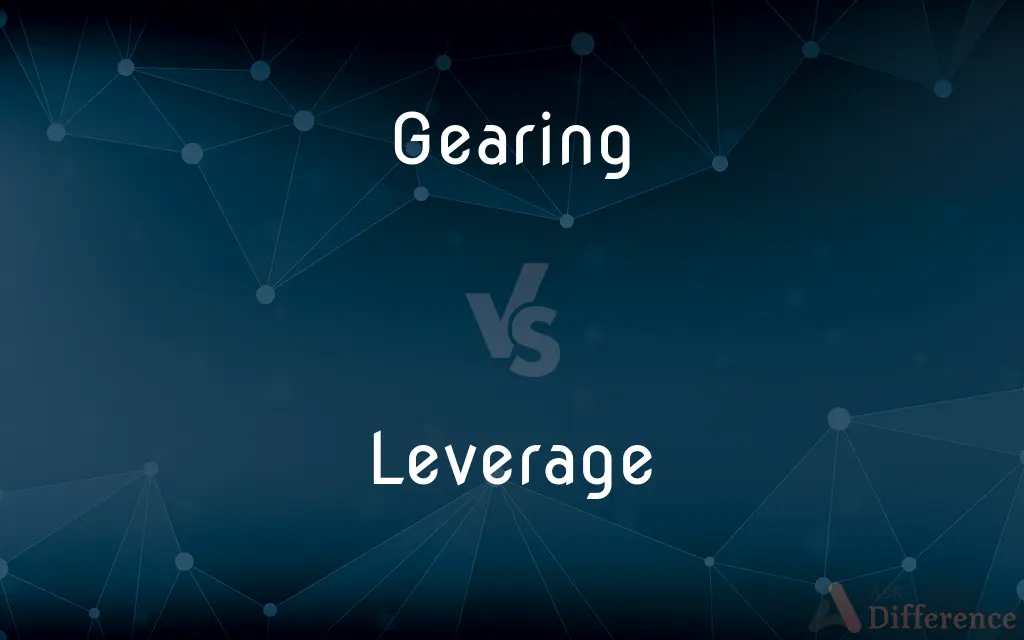Gearing vs. Leverage — What's the Difference?
Edited by Tayyaba Rehman — By Urooj Arif — Updated on March 25, 2024
Gearing and leverage both relate to the degree of debt used by a company to finance its operations, but they emphasize different aspects of financial strategy.

Difference Between Gearing and Leverage
Table of Contents
ADVERTISEMENT
Key Differences
Gearing typically refers to the ratio between a company's debt and its equity, highlighting the balance between borrowed funds and shareholder funds. Leverage, on the other hand, often focuses on the use of borrowed funds to increase the potential return on investment, which can amplify both gains and losses.
Gearing is often used in the context of a company's financial structure, indicating how much of the company's operations are financed through debt as opposed to equity. High gearing means a company has more debt relative to equity, which can increase financial risk. Leverage, while similar, is more broadly applied to any means of amplifying returns, which can include borrowing money, using derivatives, or other financial instruments.
In terms of financial metrics, gearing ratios such as debt-to-equity or equity gearing are commonly used to assess a company's financial health and risk. Leverage, meanwhile, is represented through various ratios like the debt-to-assets ratio, operating leverage, and financial leverage, each providing insight into different aspects of leveraging practices.
The implications of gearing and leverage also differ. High gearing increases the risk to shareholders during economic downturns due to fixed interest obligations, potentially leading to financial distress. High leverage can magnify returns but also losses, making investments riskier but potentially more rewarding.
Understanding the nuances between gearing and leverage is crucial for investors and financial analysts as it helps assess the risk and potential return of an investment, guiding better decision-making in financial planning and investment strategies.
ADVERTISEMENT
Comparison Chart
Definition
Ratio of a company's debt to equity, reflecting financial structure.
Use of borrowed funds to amplify potential returns on investment.
Focus
Balance between debt and shareholder funds in financing.
Amplification of investment returns, considering both gains and losses.
Common Ratios
Debt-to-equity ratio, equity gearing.
Debt-to-assets ratio, operating leverage, financial leverage.
Risk Implication
High gearing increases financial risk during downturns.
High leverage magnifies both potential returns and losses.
Application
Primarily in assessing financial health and structure.
Broadly in investment strategies to increase potential gains.
Compare with Definitions
Gearing
Ratio of Debt to Equity.
A company with higher debt compared to its equity is said to have high gearing.
Leverage
Amplification of Returns.
Leverage allows investors to potentially increase their investment returns.
Gearing
Financial Structure Indicator.
Analysts use gearing ratios to assess a company's financial stability and risk.
Leverage
Risk and Reward Balance.
While leverage can enhance returns, it also increases the risk of losses.
Gearing
Equity Financing Focus.
A low-geared company mainly uses shareholder funds for financing.
Leverage
Application in Investments.
Investors use leverage in real estate by taking out mortgages to buy properties.
Gearing
Economic Impact Sensitivity.
High gearing makes a company more vulnerable to economic downturns.
Leverage
Financial Instruments Utilization.
Leverage involves using various financial instruments like derivatives for higher gains.
Gearing
Interest Obligation Concern.
Companies with high gearing face significant interest payment pressures.
Leverage
Use of Borrowed Funds.
Through leverage, a company or investor borrows funds to invest in growth opportunities.
Gearing
A system of gears and associated elements by which motion is transferred within a machine.
Leverage
The action of a lever.
Gearing
The act or technique of providing with gears.
Leverage
The mechanical advantage of a lever.
Gearing
The ratio of a system of gears.
The 4×4 could climb well, as it had relatively low gearing.
Leverage
Positional advantage; power to act effectively
"started his ... career with far more social leverage than his father had enjoyed" (Doris Kearns Goodwin).
Gearing
Harness; working implements.
Leverage
The use of credit or borrowed funds, often for a speculative investment, as in buying securities on margin.
Gearing
A train of toothed wheels and pinions.
Leverage
To provide (a company) with leverage.
Gearing
(finance) leverage
Leverage
To supplement (money, for example) with leverage.
Gearing
Present participle of gear
Leverage
To improve or enhance
"It makes more sense to be able to leverage what we [public radio stations] do in a more effective way to our listeners" (Delano Lewis).
Gearing
Harness.
Leverage
To use so as to obtain an advantage or profit
Leveraged their personal contacts to find new investors.
Gearing
The parts by which motion imparted to one portion of an engine or machine is transmitted to another, considered collectively; as, the valve gearing of a locomotive engine; belt gearing; esp., a train of wheels for transmitting and varying motion in machinery.
Leverage
A force compounded by means of a lever rotating around a pivot; see torque.
A crowbar uses leverage to pry nails out of wood.
Gearing
Wheelwork consisting of a connected set of rotating gears by which force is transmitted or motion or torque is changed;
The fool got his tie caught in the geartrain
Leverage
(by extension) Any influence which is compounded or used to gain an advantage.
Try using competitors’ prices for leverage in the negotiation.
Leverage
(finance) The use of borrowed funds with a contractually determined return to increase the ability to invest and earn an expected higher return, but usually at high risk.
Leverage is great until something goes wrong with your investments and you still have to pay your debts.
Leverage
(finance) The debt-to-equity ratio.
Leverage
(business) The ability to earn very high returns when operating at high-capacity utilization of a facility.
Their variable-cost-reducing investments have dramatically increased their leverage.
Leverage
To use; to exploit; to manipulate in order to take full advantage (of something).
They plan to leverage the publicity into a good distribution agreement.
They plan to leverage off the publicity to get a good distribution agreement.
Leverage
The action of a lever; mechanical advantage gained by the lever.
Leverage
The mechanical advantage gained by being in a position to use a lever
Leverage
Strategic advantage; power to act effectively;
Relatively small groups can sometimes exert immense political leverage
Leverage
Investing with borrowed money as a way to amplify potential gains (at the risk of greater losses)
Leverage
Supplement with leverage;
Leverage the money that is already available
Leverage
Provide with leverage;
We need to leverage this company
Common Curiosities
What are the risks of high gearing?
High gearing increases a company's vulnerability to economic downturns and financial distress due to the obligation to pay interest on debt.
Can leverage apply to individual investments?
Yes, leverage can be applied to individual investments, such as buying stocks on margin or investing in real estate through mortgages.
What is a high gearing ratio?
A high gearing ratio indicates that a company has a significant amount of debt compared to its equity, suggesting a higher financial risk.
How does leverage work?
Leverage involves using borrowed funds or financial instruments to amplify potential investment returns, increasing both the potential for gains and losses.
Is leverage only about borrowing money?
While borrowing is a common form of leverage, it can also involve using other financial instruments like derivatives to increase potential returns.
Can a company have both high gearing and high leverage?
Yes, a company can have both high gearing and high leverage, indicating significant use of debt and a high potential for amplified returns or losses.
Can leverage be beneficial in a stable economy?
In a stable economy, leverage can be beneficial by providing opportunities for growth and higher returns with manageable risk.
How do investors use gearing ratios?
Investors use gearing ratios to assess a company's financial health, risk, and the balance between debt and equity financing.
What is gearing in financial terms?
Gearing refers to the ratio between a company's debt and its equity, indicating how much of the company's operations are financed through borrowed funds versus shareholder funds.
What is the difference between operational and financial leverage?
Operational leverage relates to a company's fixed versus variable costs, while financial leverage concerns the use of debt to finance operations.
What factors influence a company's gearing decision?
Factors include interest rates, economic conditions, the company's growth stage, and the cost of equity versus debt.
Does leverage always lead to higher returns?
Leverage can lead to higher returns, but it also increases the risk of substantial losses, making it not always beneficial.
How does high leverage affect an investor's risk?
High leverage increases an investor's risk by magnifying potential losses in addition to potential gains.
How do economic downturns impact highly geared companies?
Economic downturns can severely impact highly geared companies due to reduced revenues and the constant obligation to pay interest on debt.
What strategies can companies use to manage high gearing?
Companies can manage high gearing through refinancing, equity issuance, cost reduction, and focusing on cash flow generation to reduce debt.
Share Your Discovery

Previous Comparison
Etching vs. Engraving
Next Comparison
Mizuame vs. SugarAuthor Spotlight
Written by
Urooj ArifUrooj is a skilled content writer at Ask Difference, known for her exceptional ability to simplify complex topics into engaging and informative content. With a passion for research and a flair for clear, concise writing, she consistently delivers articles that resonate with our diverse audience.
Edited by
Tayyaba RehmanTayyaba Rehman is a distinguished writer, currently serving as a primary contributor to askdifference.com. As a researcher in semantics and etymology, Tayyaba's passion for the complexity of languages and their distinctions has found a perfect home on the platform. Tayyaba delves into the intricacies of language, distinguishing between commonly confused words and phrases, thereby providing clarity for readers worldwide.














































